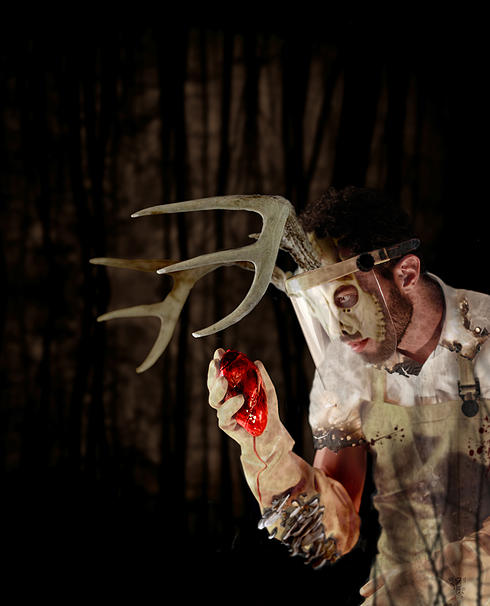Review of October in the Chair by oldsoundroom
 Something for Halloween. Oldsoundroom, a theatrical troupe consisting of recent Yale School of Drama MFAs, has mounted a creepy collection of tales from popular fantasy writer and comics artist/author Neil Gaiman. October in the Chair and Other Fragile Things plays through Sunday afternoon at The American Theatre of Actors on W. 54 Street in New York as part of the Araca Project.
Something for Halloween. Oldsoundroom, a theatrical troupe consisting of recent Yale School of Drama MFAs, has mounted a creepy collection of tales from popular fantasy writer and comics artist/author Neil Gaiman. October in the Chair and Other Fragile Things plays through Sunday afternoon at The American Theatre of Actors on W. 54 Street in New York as part of the Araca Project.
Directed by Michael McQuilken and assistant director Jennifer Harrison Newman, the show abounds in energy, atmosphere, and macabre situations. The framing tale comes from a story called “October in the Chair” wherein the months are to take turns telling stories to one another. The OSR production takes this basic premise and incorporates other Gaiman tales for select months to tell. Presided over by October (William DeMeritt) in a great horned mask and an islander accent, the interactions amongst the months are quite diverting in their own right, as August (Jackson Moran) interrupts often, and May (Laura Gragtmans) cowers and blubbers, and February (Elia Monte-Brown) acts imperious and disdainful, while March (Michael McQuilken) acts as “tune-maker,” providing the incidental music to the tales by the others.
The star of the production is Moran (the only actor present not a founding member of OSR) whose August is an obstreperous figure, with a Tom Waits-like voice full of malevolence toward others. He complains when February tries to retell a story she previously told, and generally criticizes. The troupe of five players transform themselves to play the roles in the different stories, and Moran gets many choice moments—first, he’s in his own tale (“Feeders and Eaters”) as its jaundiced narrator, then he provides expressive mime movements and clown acting as Harlequin in the tale February tells, “Harlequin Valentine.” He’s also the sad and sweet ghost-child in October’s tale, a clever rascal in “Sunbird” (March’s tale), and a stagey interlocutor who challenges his brother (Gragtmans) to swordplay in May’s tale (“Forbidden Brides of the Faceless Slaves in the Secret House of the Night of Dreams”), in which he also creates the voice and manner of a rather self-effacing raven (a fascinating puppet devised by Elizabeth Barrett Groth).
The stories, in Groth’s design, make the most of the space—its height, with catwalk, its dark recesses, its ramshackle appearance. Each story also commands an entirely different tone as Gaiman is a writer who likes to “write in the manner of” when he chooses—a tactic made much of in “Forbidden Brides” with its high-toned, well-heeled British author, under a curse, attempting to churn out another story, only to have the well-meaning raven suggest he write “fantasy,” conceived as mundane, real-world fiction. The pastiche quality of the story makes it the busiest enactment, with plenty of comic asides and extremes of horror-movie acting from Monte-Brown and DeMerrit. “Harlequin,” as well, shifts the dominant mood, this time toward Romance, though with a grisly detail (and great use of Foley effects), and “Sunbird,” with the whole troupe gathered around March’s piano, takes on the manner of a rollicking send-up of the Epicurean Club, a gathering of decadents who search the world for some delicacy yet uneaten, though the set-up is a bit long and its tone is more music hall than Grand Guignol.
Eating is a recurring theme in these tales—and why not, don’t kids on Halloween go about demanding “something good to eat”?—and nowhere more strikingly than in August’s rather unsavory story-within-a-story as a hapless former acquaintance, played with striking conviction in an Irish accent by DeMerrit (indeed, it's fun to count the accents as the night wears on, particularly from DeMerrit and Monte-Brown), narrates his rather ominous tale. As the first story in the play, August’s becomes a tough act to follow, though its arguably bested by October’s plaintive tale with Gragtmans (who provides the more sympathetic roles) as a family’s put-upon “Runt” who steals away into a creepy forest made agreeable by a boy who got sick and died.
A running joke throughout the play is provided by the fact that each storyteller in turn gets to demand “terms”—a form of payment that entails a demand about a future state of affairs. Doomsday scenarios and their anecdotes get offered in a one-upmanship that keeps something at stake in the tale-telling.
With its atmospheric lighting by Solomon Weisbard, Groth’s moody set—featuring skeletal trees provided by Gaiman himself—and McQuilken’s sound design and score, October in the Chair will keep you in yours, even if the Chechuchin Theater leaves a bit to be desired in comfortable accommodation.
oldsoundroom October in the Chair & Other Fragile Things Based on the short stories of Neil Gaiman Directed and scored by Michael McQuilken Adapted by the Ensemble
Ensemble: William DeMeritt, Laura Gragtmans, Elia Monte-Brown, Jackson Moran, and Michael McQuilken
Production design / puppets: Elizabeth Barrett Groth; Lighting design: Solomon Weisbard; Masks and Sunbird puppet: Michael McQuilken; Clothing donated by Nicholas K; Stage management: Catherine Costanzo; House management: Xaq Webb; Producer and assistant director: Jennifer Harrison Newman
The American Theatre of Actors 314 W. 54th Street New York, NY
October 29-November 2, 2014